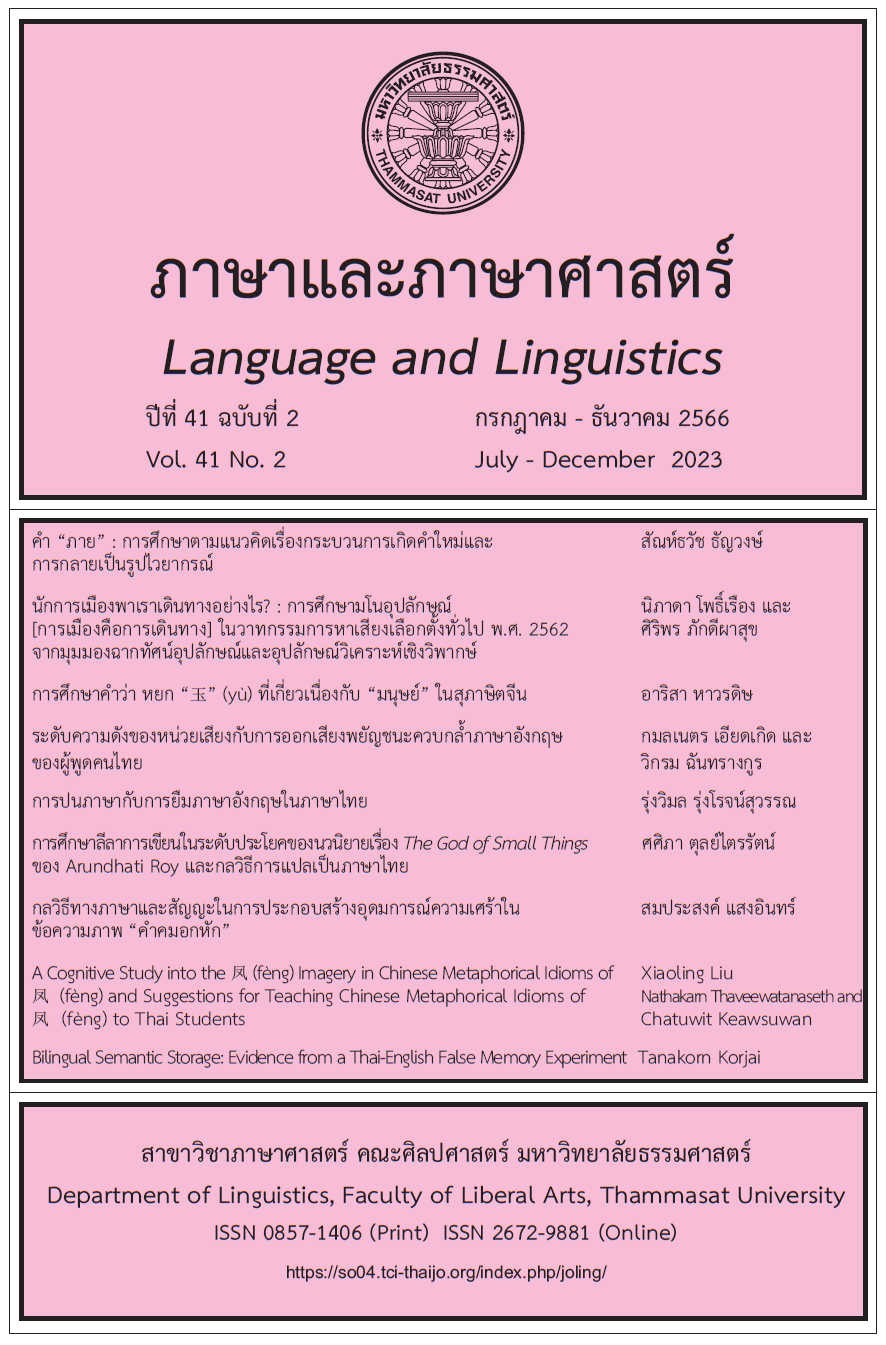The Relative Degree of Sonority and English Consonant Clusters Produced by Thai Speakers
Main Article Content
Abstract
The sonority sequencing principle (SSP) is one of the factors affecting the difficulty of consonant cluster production. Regarding a universal preference syllable of CV, consonant clusters produced by non-native English speakers are usually simplified. This research aims to investigate the relative degree of sonority to English consonant cluster pronunciation of Thai speakers, and to examine the characteristics of English consonant clusters. Twenty Thai speakers aged 30-45 years old were asked to record themselves reading Bamford-Kowel-Bench (BKB) Standard Sentence Lists. A total of 1,460 tokens (73 words x 20 speakers) were collected from the speakers’ audio recordings. The results showed that the SSP did not affect pronunciation difficulty of English consonant clusters produced by Thai speakers. The types of cluster modification were deletion, substitution, and epenthesis, respectively.
Article Details

This work is licensed under a Creative Commons Attribution-NonCommercial-NoDerivatives 4.0 International License.
บทความทุกบทความเป็นลิขสิทธิ์ของภาษาและภาษาศาสตร์
References
จรัญวิไล จรูญโรจน์. (2555). ภาษาศาสตร์เบื้องต้น (พิมพ์ครั้งที่ 5). สำนักพิมพ์มหาวิทยาลัยเกษตรศาสตร์.
จุไรรัตน์ สวัสดิ์, เสน่ห์ สวัสดิ์, และ วจี พวงมณี. (7-9 สิงหาคม 2560). ศึกษาปัญหาการสื่อสารภาษาอังกฤษกับอาจารย์ชาวต่างประเทศของนักศึกษาสาขาวิชาภาษาอังกฤษเพื่อการสื่อสารสากล มหาวิทยาลัยเทคโนโลยีราชมงคลล้านนา น่าน. ใน การประชุมวิชาการมหาวิทยาลัยเทคโนโลยีราชมงคล ครั้งที่ 9 หัวข้อ ราชมงคลสร้างสรรค์นวัตกรรมที่ยั่งยืนสู่ประเทศไทย 4.0 (Creative RMUT and Sustainable Innovation for Thailand 4.0). ศูนย์แสดงสินค้าและการประชุม อิมแพ็ค, เมืองทองธานี, นนทบุรี.
ประพินท์ สังขา. (2564). สภาพปัญหาและการแก้ไขการออกเสียง ร ล และคำควบกล้ำของเยาวชนไทย. วารสารบัณฑิตแสงโคมคำ, 6(1), 150-164.
ปรารมภ์รัตน์ โชติกเสถียร. (2557). การออกเสียงสระและเสียงพยัญชนะใน ภาษาอังกฤษ. สำนักพิมพ์แห่งจุฬาลงกรณ์มหาวิทยาลัย.
ภูรินันท์ หิรัญยูปกรณ์ และ ขนิษฐา ใจมโน. (2557). การแปรของ /r/ ในตําแหน่งพยัญชนะควบกลํ้าต้นพยางค์ในคําภาษาอังกฤษตามวัจนลีลาและประสบการณ์ทางภาษาอังกฤษของนิสิตสาขาวิชาเอกภาษาอังกฤษ. ใน มหาวิทยาลัยขอนแก่น, บัณฑิตวิทยาลัย. การประชุมวิชาการเสนอผลงานวิจัยระดับบัณฑิตศึกษา ครั้งที่ 15: 50 ปี มข. แห่งการอุทิศเพื่อสังคม (pp. 2350-2361). มหาวิทยาลัยขอนแก่น.
รัตนสุวรรณ ระวรรณ, ธีราภรณ์ รติธรรมกุล, และ ศุจิณัฐ จิตวิริยนนท์. (2561). หลักการการเรียงพลังประจำเสียงกับการรับรู้เสียงควบกล้ำพยัญชนะที่ผิด สัทสัมผัสของภาษาแม่. วารสารวจนะ, 6(2), 15-32.
อดิศักดิ์ ย่อมเยาว์. (2561). ปัญหาการใช้ทักษะภาษาอังกฤษที่จำเป็นสำหรับพยาบาลวิชาชีพที่ปฏิบัติงานในโรงพยาบาล ขนาดกลางและโรงพยาบาลขนาดใหญ่ ในจังหวัดเชียงราย. วารสารวิชาการสมาคมสถาบันอุดมศึกษาเอกชนแห่งประเทศไทย ฉบับมนุษยศาสตร์และสังคมศาสตร์, 23(2), 56-66.
Alenazi, A. R. (2016). The production of English coda clusters by Aljouf Arabic speakers. International Journal of English Linguistics, 6(2), 34-42. http://doi.org/10.5539/ijel.v6n2p34
Almalki, H. (2014). Acoustic investigation of production of clusters by Saudi second language learners of English [Master's thesis]. Florida International University.
Bassetti, B., Escudero, P., & Hayes-Harb, R. (2015). Second language phonology at the interface between acoustic and orthographic input. Applied psycholinguistics, 36(1), 1-6.
Bench, J., Kowal, Å., & Bamford, J. (1979). The Bkb (Bamford-Kowal-Bench) sentence lists for partially-hearing children. British Journal of Audiology, 13(3), 108-112. https://doi.org/10.3109/03005367909078884
Berent, I., Steriade, D., Lennertz, T., & Vaknin, V. (2007). What we know about what we have never heard: Evidence from perceptual illusions. Cognition, 104(3), 591-630.
Boersma, P., & Weenink, D. (2021). Praat: Doing phonetics by computer (Version 6.2.12) [Computer software]. www.praat.org.
Choi, J. (2016). Investigation into Korean EFL learners’ acquisition of English /s/ + consonant onset clusters. Advances in Language and Literary Studies, 7(2), 48-54.
Clement, G. (1992). The sonority cycle and syllable organization. In W. Dressler, H. Luschutzky, O. Pfeiffer, & J. Rennison (Eds.), Phonologica 1988 (pp. 63-76). Cambridge University Press.
Eckman, F. R. (1977). Markedness and the contrastive analysis hypothesis. Language Learning, 27(2), 315-330.
Eckman, F. R., & Iverson, G. K. (1994). Pronunciation difficulties in ESL: coda consonants in English interlanguage. In M. Yavas (Ed.), First and second language phonology (pp. 251-265). Singular.
Ellis, R. (2010). The Study of Second Language Acquisition. Oxford University Press.
Fletcher, S. G. (1972). Time-by-count measurement of diadochokinetic syllable rate. Journal of Speech and Hearing Research, 15(4), 763-770.
Jenkins, J. (2009). The phonology of English as an international language. Oxford University Press.
Kreidler, C. W. (2008). The pronunciation of English: A course book. John Wiley & Sons.
Le, H. T., & Boonmoh, A. (2020). Thai students' production of English coda clusters. Human Behaviour, Development and Society, 21(2), 17-29.
Odlin, T. (1989). Language transfer: Cross-linguistic influence in language learning. Cambridge University Press.
Panichkul, S. (2018). A study of the pronunciation of English consonant clusters by Thai speakers in the airline business. In S. Saengboon, R. Rojjanaprapayon, & H. Goto (Chairs), The 8th international conference on language and communication: Reclaiming language, communication and culture for sustainable society (pp. 139-153). the National Institute of Development Administration (NIDA), Bangkok, Thailand.
Parker, S. (2008). Sound level protrusions as physical correlates of sonority. Journal of Phonetics, 36(1). 55-90.
Parker, S. (2012). The sonority controversy. Mouton de Gruyter. http://doi.org/10.1515/9783110261523
Roach, P. (2016). English phonetics and phonology: A practical course (4th ed.). Cambridge University Press.
Rungruang, A. (2017). Consonant cluster acquisition by L2 Thai speakers. English Language Teaching, 10(7), 216-231.
Shinohara, Y. (2014). Perceptual training of English /r/ and /l/ for Japanese adults, adolescents and children [Doctoral dissertation]. University College London.
Shoji, S., & Shoji, K. (2014). Vowel epenthesis and consonant deletion in Japanese loanwords from English. In J. Kingston, C. Moore-Cantwell, J. Pater, R. Staubs (Eds.), Proceedings of the 2013 Annual Meeting on Phonology (pp. 1-12). University of Massachusetts Amherst, MA, United States. https://doi.org/10.3765/amp.v1i1.16
Wadsorn, N., & Panichkul, S. (2014). ‘River’ or ‘Liver’? Exploring the Intelligibility of Thai’s (Mis)pronunciation of English ‘r’ and ‘l’. LEARN Journal: Language Education and Acquisition Research Network, 7(2), 51-67.
Winskel, H., Luksaneeyanawin, S., & Yangklang, P. (2006). Language socialisation of the child through caretaker-child personal narratives: A comparison of Thai and English. RELC Journal, 37(3), 356-368.


